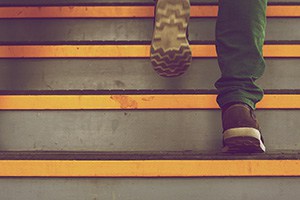According to the National Council on Aging, 1 in 4 Americans over the age of 65 suffer a serious fall every year. Especially for seniors, falls can be very serious. Senior falls are more likely to result in brain injuries and broken bones. Stairs are one of the biggest culprits in causing senior falls, they can be risky for older adults. However, they are often overlooked as a safety hazard since they’re something that has always been around without trouble. But as we age, we begin to deal with decreased mobility, chronic pain or vision issues that lead to problems involving stairs. These problems do not need to drive seniors out of their beloved homes, though. The following list outlines ways to make stairs safer so that you or your loved one can live more independently and safely.
1. Invest in a stairlift.
This is, hands-down, the safest way for seniors to use the stairs. Electric stairlifts have a seat that moves slowly and smoothly up and down the stairs. They’re very simple to use. Have a complicated stairway? No problem. Stairlifts come in a variety of models that can fit in both straight, curved, and multi-level stairways. There are even stairlift models that are designed for outdoor use. You might think that installing a stairlift is a complicated, long process. However, they are actually easily installed in one day and they’re very non-invasive. They don’t damage walls and can even stow conveniently away so that others can use the stairs without obstruction.
2. Install railings.
According to the CDC, railings are an important safety feature of any senior’s living area. In the home, stairways should have railings on both sides and they should be easy to grip. Additionally, they should be securely fastened and run the entire length of the stairs with no gaps.
3. Toss carpet runners.
While carpet runners may be a lovely decorative addition to stairs, they can cause tripping hazards, especially for those seniors already unsteady on their feet.
4. Install non-slip strips.
Especially if floors are hardwood or tile, non-slip strips can help provide grip on an otherwise slippery surface.
5. Install extra lighting.
Shadows are not conducive to safe stair usage by seniors, so it’s important to make sure stairways are well-lit to help those dealing with vision impairments.
6. Eliminate clutter.
Stairs should be clear of clutter at all times. It is common in households to use the first few stairs as a place to store items (even temporarily) that need to eventually go upstairs. These can present serious fall risks for seniors, especially those with vision impairments because they might assume the path is clear and not realize some piles of laundry or knick knacks have been added to the stairs. It’s much better to keep a table or basket near the stairs to store those temporary things that need to go upstairs at a later time.
7. Paint in contrasting colors.
Because many seniors may suffer from vision difficulties, it can be a challenge to see where each step ends and the next begins. It can be helpful to paint the stairs in contrasting colors to help eliminate this issue. You can make it fun and incorporate the senior’s favorite colors, or find unique design ideas online to make the contrasting colors look more appealing.
8. Prevention is key, when possible.
Seniors dealing with decreased mobility and chronic pain can participate in exercises (under the supervision of their medical provider) to strengthen their muscles and decrease their risk for falls. Implementing these tips can extend the senior’s ability to live in their beloved home independently, as well as make them more aware of stair safety and decrease the risk for potentially-dangerous falls. ————————– Want to learn more about senior living at its finest? Give our team of care professionals a call today to chat about your options.





